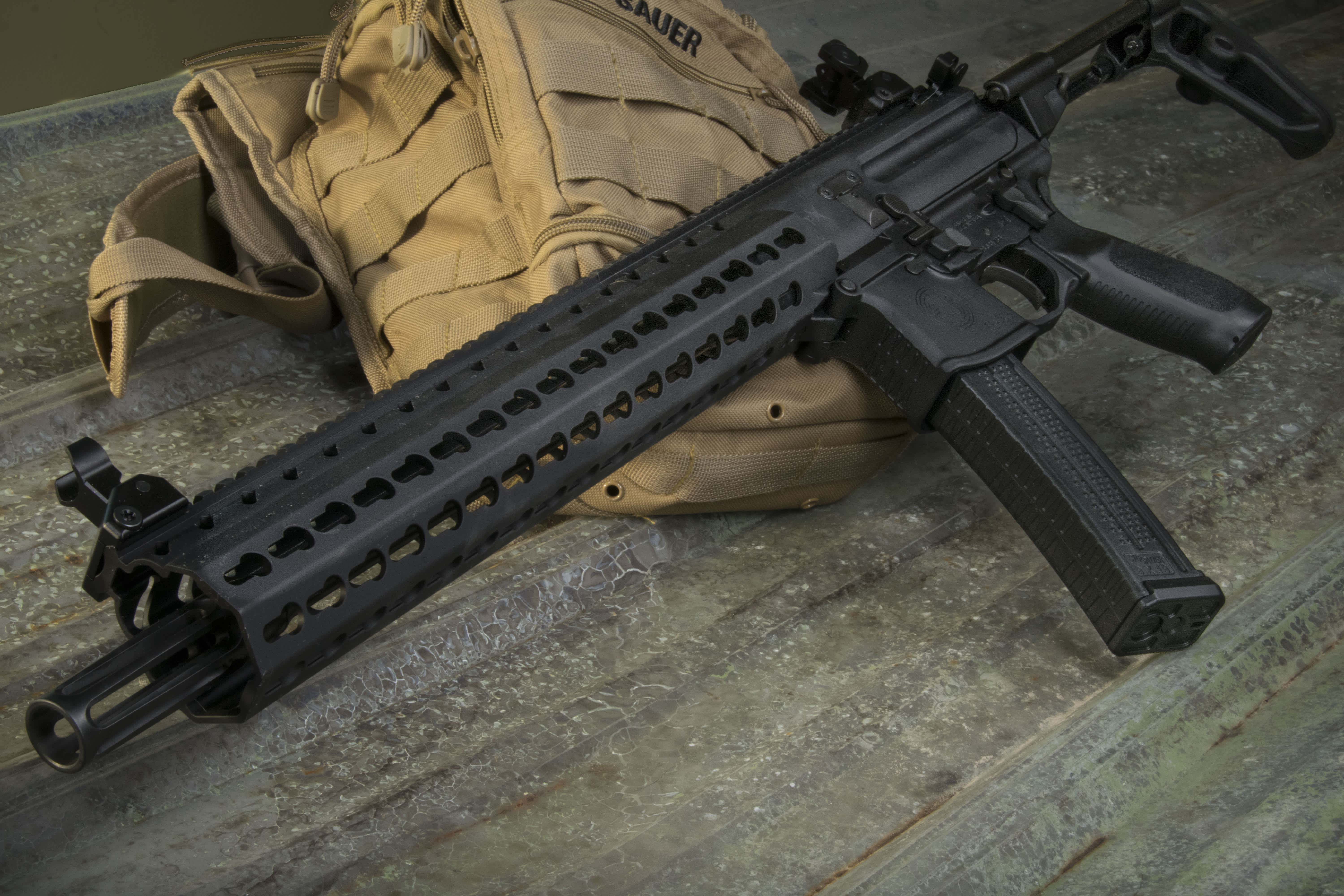Review: New Sig Sauer MPX Carbine
OutdoorHub Staff 10.11.16

Pistol caliber carbines have always been a guilty pleasure of mine. I say guilty because the pragmatist in me fully understands they are ballistically outclassed by traditional rifle-caliber carbines. Even still, the soft-shooting nature and interchangeability of ammunition between them and my handguns further fuels my desire to own them.
That said, it’s not as if I run around buying every shoulder-fired 9mm I can find. I’m actually very picky about these guns, primarily because of my pragmatism; if I’m going to sacrifice terminal ballistics, I ought to gain something in return. Benefits such as decreased ammunition cost, better-suppressed performance, and reduced recoil impulse.
While the first two are common among nearly all pistol caliber carbines, the last is not. This is because most pistol caliber carbines utilize direct blowback as a means of operation. By doing so, the shooter is forced to absorb much of the impulse to their shoulder. Though there are a few exceptions, like the Heckler & Koch MP5 with its roller-delayed action, and the most recent addition to the pistol caliber carbine roster, the SIG Sauer MPX Carbine.
Unlike most of these semi auto carbines, the MPX utilizes a short-stroke, piston-driven action. This has the advantage over blowback firearms in reducing felt recoil by delaying the unlocking of the action until pressure levels drop within safe parameters. Another benefit of this method of operation is reduced bolt, and thus overall weight, as well as decreased recoil spring tension. The latter being beneficial by making the rifle’s action easier to charge.

The MPX shares its method of operation with its 556 big brothers, the SIG 516 and the MCX. Like both of these rifles, it utilizes the same polymer pistol grip – one that features aggressive stippling and a comfortable palm swell that narrows toward the top so as to not affect trigger reach. Also, like the MCX, the MPX features an ambidextrous magazine release button, but unlike the 556 MCX, the MPX has an ambi bolt release.

Shooters familiar with the AR-15 family of rifles will immediately feel at home with the MPX. Its controls are virtually identical: it uses the same type of fire selector, bolt release mag release, and a very similar charging latch (it’s slightly smaller than the 556 version). Though as I mentioned above, the bolt release differs slightly in that it also has a right-side release button in additional to the hold open latch found on AR-15 carbines.
While initially somewhat awkward, this release latch speeds up reloads considerably with practice, since they don’t have to slap the side of the receiver to put the bolt in battery.
One aspect that I’m torn on about the MPX is its magazines. Don’t get me wrong, I think they are arguably some of the finest submachine gun/pistol caliber carbine magazines in existence, but they’ve priced accordingly. On one hand, it would have been nice to see the carbine use an existing magazine design to make sure shooters could buy plenty without drastically raising its cost of ownership.
On the other hand, magazines are normally the culprit behind malfunctions. Buy designing a proprietary magazine with an industry-leading magazine design like Lancer Systems, SIG can ensure shooters won ‘t have to deal with reliability issues stemming from old mags.
You read that right – the MPX uses a new type of polymer magazine made by Lancer Systems. Lancer’s L5 AWM AR15 magazine is one of my personal favorites and my go-to for competitive use. Just like the L5 I adore, the MPX magazines are built from the same high-impact translucent polymer with steel reinforcements. The MPX carbine ships with a 30-round example, but 10- and 20-round varieties are also available for purchase.

The carbine reviewed looks like the MPX submachine gun designed by SIG, except it features an elongated, 13.75-inch barrel with a permanently attached 3.5-inch flasher hider. Shooters who wish to SBR the MPX carbine can do so with relative ease. Once their tax stamp is approved and their receiver engraved, they only need a pair of Allen wrenches: one to remove the handguard, and another to remove the two retaining bolts that secure the barrel to the receiver. Once removed, the barrel can be replaced with a shorter one.
Speaking of the handguards, they’re free-floated and feature KeyMod slots on seven sides. This is ideal given the massive length of the MPX’s 14-inch handguard. If the MPX carbine used a traditional railed handguard, it would be prohibitively nose heavy, and awkward to maneuver.

Reliability with the MPX is great; the carbine runs like a well-oiled machine with all variety of bullet weight and types tested. This includes ultra-light frangible ammunition, standard 115-grain and 124-grain FMJ, and subsonic 147-grain rounds as well.
Accuracy, too, is solid. Fired from a bench rest at 50 yards, the MPX achieved groups ranging from 1.9 inches to 2.7 inches, depending on ammunition. While not a match-grade sub MOA tac-driver, the MPX carbine would make an excellent home defense carbine, especially when loaded with high-quality expanding ammunition such as Hornady’s 147-grain XTP or Winchester’s PDX-1 Defender line. When pitted against a plate rack at 50 yards, even novice shooters will have no problem cleaning the rack in seconds.
The MPX carbine isn’t a traditional rifle, or even a traditional pistol caliber carbine. But that’s not a bad thing at all. The excellent ergonomics, suppressed performance (albeit gassy) and ultra-soft recoil impulse make it a fast-shooting, easy-handling plinker. It can serve double duty to protect you and your loved ones, or ride shotgun while patrolling a ranch for predators.

